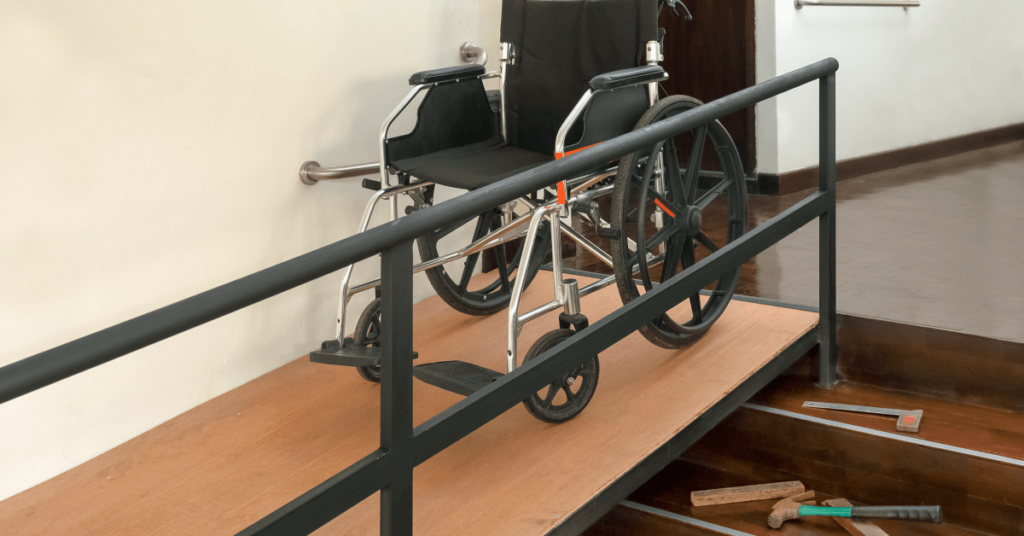8 Ways to Make a Home Wheelchair Accessible
Thursday, November 28th, 2024, 12:05 pm , Posted by MED +
Making a home wheelchair accessible is a crucial step toward ensuring that individuals with mobility challenges can live safely, comfortably, and independently. Whether you’re considering modifications for yourself or a loved one, there are several practical changes you can make to ensure that all areas of the home are easily accessible. In this blog post, we will discuss eight ways to transform your home into a wheelchair-friendly space, helping you create an environment that enhances safety, freedom, and quality of life.
1. Widen Doorways and Hallways
One of the first and most important steps in making a home wheelchair accessible is widening the doorways and hallways. Standard doorways are typically 30 to 32 inches wide, which may not be sufficient for a wheelchair. To ensure safe and easy passage, it is recommended to widen doorways to at least 36 inches. Hallways should also be wide enough to allow for smooth movement. A minimum of 42 inches is recommended to accommodate a wheelchair comfortably and to allow enough room for turning.
You can achieve this by removing or replacing door frames, adjusting hinges, or installing sliding doors. In narrow hallways, furniture should be rearranged or minimized to ensure that the space remains clear and accessible.
2. Install Ramps for Entry and Exit
For wheelchair users, ramps are essential for smooth entry and exit from the home. If your home has stairs, replacing them with a ramp is a must. When designing a ramp, ensure that the slope is gradual to prevent it from being too steep. The ideal slope ratio is 1:12, meaning for every inch of rise, the ramp should be 12 inches long.
The width of the ramp should be at least 36 inches to allow ample space for maneuvering, and it should be made from a slip-resistant material to prevent accidents. Adding handrails to both sides of the ramp also provides additional stability and safety.
3. Modify the Bathroom for Accessibility
The bathroom is one of the most important areas to modify in order to make a home wheelchair accessible. A few key adjustments can ensure that the space is safe and comfortable for wheelchair users:
- Roll-In Showers: Traditional bathtubs and showers are difficult for wheelchair users to access. A roll-in shower with no lip or barrier allows a wheelchair to roll directly into the shower area. Ensure that the shower has non-slip flooring, grab bars, and a fold-down seat for extra comfort.
- Adjust Sink Height: Ensure that sinks are installed at a height that is easily accessible from a wheelchair. Wall-mounted sinks work well, as they allow space for the wheelchair to fit underneath. This provides users with ample room to comfortably use the sink for washing hands or brushing teeth.
- Install Grab Bars: Grab bars should be placed strategically around the shower, toilet, and bathtub for additional support. These bars should be sturdy and located at the proper height for easy access.
4. Ensure Smooth and Accessible Flooring
Flooring can significantly affect a wheelchair user’s ability to move around the home. Avoid thick carpets, rugs with high piles, and uneven flooring, as these can make it difficult to navigate. Instead, opt for smooth, hard flooring materials such as vinyl, tile, or wood. These surfaces are much easier for a wheelchair to roll over.
For safety, choose non-slip flooring to prevent falls. In high-traffic areas such as hallways and bathrooms, adding anti-slip mats can provide extra stability. If carpets are essential, choose low-pile carpeting, which is easier to navigate.
5. Create Accessible Kitchen Spaces
The kitchen is another area that requires careful consideration when making a home wheelchair accessible. Modifying the layout and features in the kitchen can make cooking, cleaning, and other activities much easier for a wheelchair user.
- Lowered Countertops and Cabinets: Installing lower countertops at wheelchair-friendly heights makes them easier to access. The ADA recommends that kitchen counters be between 28 and 34 inches high for wheelchair users. Lowered cabinets and pull-out shelves also provide more accessible storage.
- Accessible Appliances: Many modern appliances are designed with accessibility in mind. Opt for side-opening ovens, which are easier to access from a seated position, or install appliances at a lower height. A pull-out or pull-down kitchen faucet with easy-to-grip handles is another useful feature.
- Clear Floor Space: Allow enough room for the wheelchair to move around the kitchen. There should be sufficient space between counters, appliances, and the island, ideally 60 inches of clearance to allow for a full turning radius.
6. Increase Lighting and Visibility
Proper lighting is essential to ensure a safe and accessible environment for wheelchair users. Low visibility can increase the risk of accidents, especially when navigating dark areas or stairs. Installing bright, well-placed lights throughout the home is key.
Consider using motion-sensor lighting in hallways and bathrooms, which automatically turn on when someone approaches. For task areas such as the kitchen or bathroom, install under-cabinet lighting to illuminate countertops and sinks. Additionally, using higher-wattage bulbs can help brighten up rooms and ensure that the entire space is well-lit.
7. Optimize Furniture and Layout
An accessible home should have clear pathways, especially in areas that require movement with a wheelchair. Ensure that the furniture layout is open and doesn’t block doorways or narrow passageways. Use furniture with rounded edges to prevent injury and make it easier to navigate through spaces.
Consider using chairs and couches with higher seating to make transfers from a wheelchair easier. If possible, opt for lightweight furniture that can be moved or adjusted to accommodate different needs. This way, the space remains flexible, and wheelchair users can easily get through rooms without any obstruction.
8. Add Smart Home Technology
Incorporating smart home technology can enhance accessibility for wheelchair users. Voice-controlled devices, such as smart assistants (Amazon Alexa or Google Home), can be used to control lighting, temperature, security systems, and even appliances without the need for physical interaction.
Automated doors, smart thermostats, and remote-controlled blinds can all make a home more convenient and comfortable for wheelchair users. For example, automatic door openers can help users enter and exit rooms or buildings without needing to manually open doors. These technologies can also improve safety by allowing the user to control various elements of their home with minimal effort.
Conclusion
Making a home wheelchair accessible is a vital step in creating an environment that promotes independence and safety for individuals with mobility challenges. From widening doorways and installing ramps to modifying bathrooms and creating accessible kitchen spaces, there are many changes you can make to improve wheelchair accessibility. By focusing on these eight key areas—widening doorways, installing ramps, adjusting bathrooms, ensuring smooth flooring, creating an accessible kitchen, increasing lighting, optimizing furniture, and adding smart technology—you can create a space that makes daily life easier and more comfortable for wheelchair users. At MED+ Medical Equipment Distribution Inc., we are here to help you implement these changes and provide the support you need to enhance your home’s accessibility.
Browse Blog Topics
- MED+ Partners with Holmes on Homes: Building a Legacy
- 7 Reasons Why a Hospital Bed Could Be a Good Investment for Improved Home Care of a Loved One
- 8 Ways to Make a Home Wheelchair Accessible
- Walkers vs. Rollators: Which is Right for You?
- 5 Ways MED+ Works with Occupational Therapists to Enhance Mobility & Accessibility for Patients





